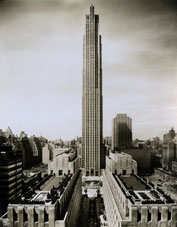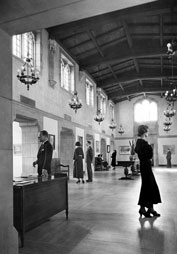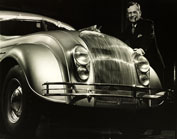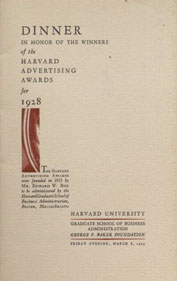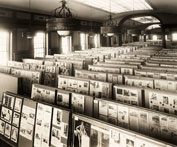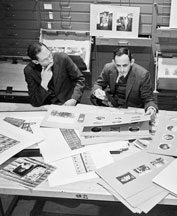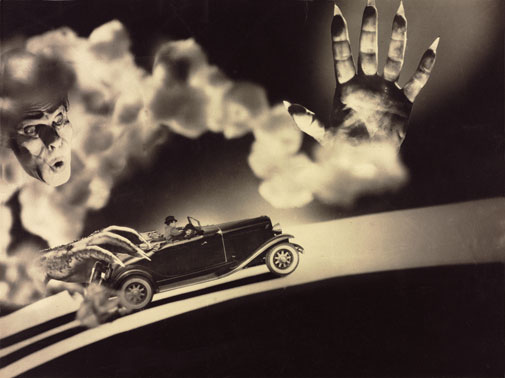The Route of the Exhibition
New York and Chicago
When the 1934 NAAI and Photographic Illustrators, Inc. exhibition opened in the mezzanine gallery at 30 Rockefeller Center and visitors gazed upon advertisements for Lucky Strike cigarettes or fashion spreads for Harper’s Bazaar, the images they saw were presented in the context of fine art. They were works, The New York Times explained, “of a high standard of artistic merit, judged by professional photographic standards, as well as a respectable level of proved commercial value.”23 The exhibition represented one of many shows of its kind sponsored by camera clubs, salons, and art organizations in the 1920s and ’30s. Eager to elevate the industry’s reputation, advertisers also supported and promoted exhibitions like those produced by the Art Directors Club of New York, which tried to strike a balance between art and business. The venues confirmed commercial images as art and offered a prestigious social milieu that brought together photographers, executives, art directors, and socialites.
In New York, the mission of the Art Center, a federation of seven societies including the Pictorialist Photographers of America, was “to foster American expression in the arts” with an emphasis on industrial and commercial arts.24 The Center hosted several shows including “Foreign Advertising Photography” in 1931, which introduced viewers to international trends. In 1932 the Center mounted its “First National Exhibition of Photographs for Commerce, Industry, and Science.” That same year, the newly formed National Alliance of Art and Industry took over the Art Center’s activities. Two years later, the NAAI joined with the Photographic Illustrators, Inc. to sponsor the exhibition at 30 Rockefeller Plaza.
After closing in New York City, the NAAI exhibition then traveled to Chicago, another metropolis where the worlds of executives, advertisers, designers, photographers, and patrons of high culture merged. The NAAI show opened in the public gallery spaces at the Lakeside Press Galleries in the flagship building of the renowned printing company R. R. Donnelley & Sons. The Lakeside Press rotating exhibitions were considered equal to those at the preeminent cultural institutions in the city, such as the Art Institute of Chicago. The Art Institute sponsored the Chicago Salon, the first photographic salon in the area, which also featured exhibitions in advertising art during the 1930s.
Shifting Contexts at Harvard
In 1935, a year after the NAAI exhibition toured New York and Chicago, approximately 125 works from the show came to Harvard Business School (HBS) to enhance the school’s photographic collections already available for exhibition, research, and classroom use. The exhibition’s themes of industry and advertising were of interest at HBS, where marketing had been part of the curriculum since 1914. In 1932, the first full course in advertising, entitled “Advertising Problems,” taught by Associate Professor Neil Borden, offered an intensive study of the place and function of advertising in business administration. Designed to “give a viewpoint to those who, as executives, will have to direct the use of advertising in the conduct of business,”25 the course provided an overview in techniques needed to “judge the possibilities of advertising as a sales tool for various types of products and sizes of firms and to formulate effective plans of sales strategy involving its use in conjunction with other sales and promotional methods.”26
Upon their arrival, the NAAI photographs became part of Baker Library’s collections, allowing successive HBS educators and students the opportunity to study the work of the preeminent advertising photographers of the day. HBS’s broadly related collecting efforts did not go unobserved. “Art and industry, human relations and market analysis, in fact most of the antithesis which are generally accepted in the world of business,” a 1932 article in the New York Times noted, “are finding new, correlated riches in the field of business education. Hence, one must not be surprised on entering the George Fisher Baker Memorial Library . . . to encounter a striking collection of paintings and photographs.”27
Artistic standards in advertising were recognized at Harvard Business School through the establishment of the Harvard Advertising Awards.28 Created in 1924 with a donation from Edward W. Bok, former editor of the Ladies’ Home Journal, the awards were distributed annually for distinguished advertising work in North American newspapers and magazines. The awards focused on numerous elements including effective campaigns, innovative marketing research,29 and, as Bok wrote, the attainment of “a higher standard of art.”30 During the competition, poster entries for the Harvard Advertising Awards crowded Baker Library’s Reading Room, showing the rising generation of HBS educated managers the latest industry trends in layout and artistic presentation, sales strategies and market research, and attempts at greater truth and accuracy in advertising. The awards gradually lent prestige to the industry as well.31 HBS Dean Wallace Donham, appointed in 1919, explained the awards were started and maintained “solely with the idea of bringing into public discussion some of the ethical dilemmas which are involved in advertising, and raising the level of both integrity and research in the field.”32
Nearly fifty years after the NAAI photographs came to Harvard Business School, a growing appreciation of historic photographs gave the collection a new import for scholars. In the 1980s, HBS placed the NAAI collection on deposit in Harvard’s Fogg Art Museum. Davis Pratt, associate curator of photography at the Fogg, previously was curator of still photography at Harvard’s Carpenter Center for the Visual Arts, known for its focus on photography’s social documentary value. Before coming to Harvard, Pratt had worked at the Museum of Modern Art (MOMA) as assistant to Edward Steichen, then director of MOMA’s Department of Photography, where he actively encouraged the investigation of photography as a mass medium of global significance.33
Pratt also undertook an early survey to locate photographic collections throughout Harvard. Through efforts such as these, the University began to uncover a wealth of images in its repositories. Pratt’s work was at the forefront of a growing trend over the next several decades as cultural institutions across the country began to reassess the inherent value of photographs as aesthetic works, documentary records, and primary research materials. In 2008 the NAAI photographs returned from Harvard’s Fogg Art Museum to the newly renovated Baker Library |Bloomberg Center. The move represented part of a multi-year initiative of the Library’s Historical Collections Department to identify, catalog, and preserve its rich photographic collections and to make them accessible to business school communities and scholars across disciplines.
The NAAI collection has come to exemplify a dynamic synergy between photography and corporate culture, illustrating the inventive visual language artists were exploring, the social and material ideals to which advertisers hoped consumers would aspire, and changing ideas about the interrelationship of fine art and commercial photography. Across more than seven decades, the collection has traversed the worlds of advertising, art, and education and served many purposes and patrons—manufacturers, advertisers, artists, historians, educators, and students of business, art, and culture.34 By removing the photographs from their original, commercial context, the 1934 NAAI venues in New York and Chicago affirmed the works as high art. Arriving at Harvard with this imprimatur, the images were assimilated into the business archive at a time when the profession of advertising was capitalizing on the use of fine art as an effective sales vehicle and discovering its potential to elevate the industry’s own standards and practices. The circuitous route of the collection within the University—from business archive to “art” collection and back again—reveals as well a deepening appreciation of photography as a significant form of cultural expression.
- H. I. Brock, “The Magic of the Clicking Camera,” New York Times, September 16, 1934.
- “Art Centre Forms A New Corporation,” New York Times, March 26, 1932.
- Official Register of Harvard University: Graduate School of Business Administration. v. XXIX, no. 28. Boston, MA: Harvard University, June 22, 1932.
- Ibid.
- “Harvard Couples Art and Industry,” New York Times, June 19, 1932.
- The Harvard Advertising Awards were distributed from 1925 until 1930, when a private foundation took them over.
- Jeffrey L. Cruikshank, A Delicate Experiment: The Harvard Business School, 1908-1945. Boston: Harvard Business School Press, 1987, p. 168.
- Harvard Graduate School of Business Administration. “Harvard Advertising Awards.” Barton, Durstine, & Osborn, Incorporated, New York, 1925.
- Edward W. Bok, “The Day of the Advertisement,” The Atlantic Monthly 132, no. 4 (October 1923): 536. Bok wrote: “As it was fitting for Columbia University, with its School for Journalism, to offer awards for journalistic and literary endeavor, the mind should turn to Harvard University, with its School of Business of Administration, and its courses therein devoted to advertising, to offer awards for the encouragement of a better quality of advertisement writing and presentation.”
- Wallace Donham, in Jeffrey L. Cruikshank, A Delicate Experiment: The Harvard Business School, 1908-1945. Boston: Harvard Business School Press, 1987, p. 168.
- Christopher Phillips, “The Judgment Seat of Photography,” October 22, The MIT Press (Autumn 1982): 27–63. “Rather than contest the peripheral status of art photography,” historian Christopher Phillips notes, at MOMA “[Steichen] was to capitalize on photography’s demonstrably central role as a mass medium that dramatically ‘interpreted’ the world for a national (and international) audience.”
- See Bogart, note 6, p. 7. Bogart contends that “changing boundaries of fine and commercial art resulted from efforts on the part of . . . advertisers . . . photographers, and assorted elite groups to claim jurisdiction over ‘art’ as a means of acquiring authority and influences in their fields and in the broader culture.”


